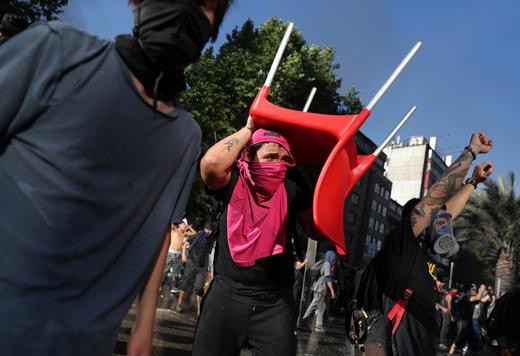How Social Media Slang Became an Instrumental Tool for Chilean Protesters

Despite some countries speaking the same language, each has a unique slang that only they and the native speakers can comprehend. Chilean protesters had been reported to be mobilizing the power of social media to let their voices be heard on a larger scale.
Last October 18, Chilean President Sebastián Piñera was seen enjoying a meal in a neighborhood for the rich called Vitacura. He was seen eating pizza when a bunch of protests has been ongoing for the increase in the fare of the metro.
The morning after this event, President Sebastián Piñera had ordered the country's military forces to control the events.
Moments later, the social media platform called Twitter had been flooded with tweets or 'tuits' and multiple memes containing the photo of the president chowing down his pizza.
His photo had circulated in social media and he was even the main subject of a meme called "El Pizza". His meme was taking social media platforms by storm with photos of police violence alongside his meme.
The social media community even created trending 'hashtags' such as #RenunciaPiñera meaning 'renounce Piñera' and #ChileDespierta which invites the people of Chile to 'wake up'.
The broad coverage of social media platforms and the unique slang of Chile had become a great combination for the effective and creative spread of the humorous slang for protests that had become the core of the movement.
The Chilean protesters have been in action for more or less two months already. Reports using the English language had put their focus on the protestors' effect on the politics of Chile and the violence in the country.
The president of the country of Chile had canceled his attendance to 2 major summits. He had also proposed methods of improvement with the Nueva Agenda Social. Currently, he is starting to create a plan to renew the constitution of the country.
Last November 19, the prosecutor's office had released a statement saying the twenty-six had lost their lives. According to the records of the National Institute of Human Rights, 2,808 people were sent to the medical care centers and 7,259 were arrested.
The National Institute of Human Rights had filed a case against the administration of Chile charging it with 499 cases of criminal actions. Out of the 499 cases, 79 were related to sexual harassment and the remaining 369 were for torture. It was reported that the 499 cases of violence to the people of Chile had occurred between the 17th of October and the 25th of November.
People who attended protests and those who were near the area of rallies had been injured from rubber bullets and tear gas emissions. It was reported that three hundred people had attained severe trauma in their eyes. The photo of a Chilean wearing a bandage on the part of his eyes had shaken the emotions of the social media community.
The use of social media to protest against the government of Chile had positively impacted the protests in the country. It is becoming the biggest movement in social media after the finale of Pinochet's leadership in the country.
The chilenismos or the one-of-a-kind and continuously evolving language of the Chileans had become an important contributory factor alongside the inequality of the Chilean economy and the violence of the government of Chile to the Chilean protesters using social media platforms.
Subscribe to Latin Post!
Sign up for our free newsletter for the Latest coverage!
© 2025 Latin Post. All rights reserved. Do not reproduce without permission.















